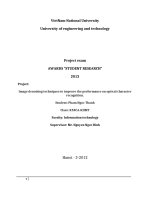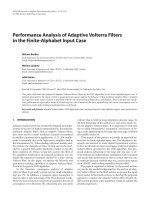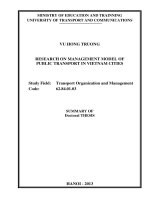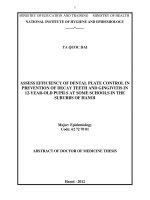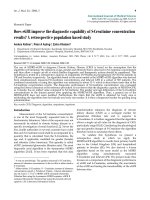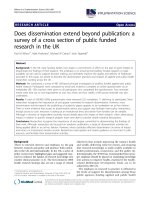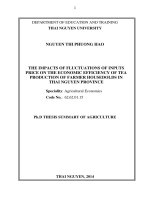IMPROVE THE PERFORMANCE EFFICIENCY OF PUBLIC TRANSPORT SYSTEM IN URBAN AREAS
Bạn đang xem bản rút gọn của tài liệu. Xem và tải ngay bản đầy đủ của tài liệu tại đây (387.05 KB, 27 trang )
1
MINISTRY OF EDUCATION AND TRAINNING
UNIVERSITY OF TRANSPORT AND COMMUNICATIONS
* * * * * * * * * * * * * * * * * *
NGUYỄN THỊ HỒNG MAI
IMPROVE THE PERFORMANCE EFFICIENCY
OF PUBLIC TRANSPORT SYSTEM
IN URBAN AREAS
Study Field: Transport Organization and Management
Code: 62.84.01.03
SUMMARY OF DOCTORAL THESIS
HA NOI- 2014
2
Training Institution: University of Transport and Communications
Supervisors: 1- Assoc.Prof.Dr Tu Sy Sua
2- Dr. Le Xuan Lan
Examination Committee Member 1: Prof.PostDr Nguyen Huu Ha
Examination Committee Member 2: Prof.Dr Ngo Thang Loi
Examination Committee Member 3: Prof.Dr Bui Xuan Phong
The thesis is defended in front of Examination Committee at University Level
In : The University of Transport and Communications
At , ………… 2014
The thesis can be found in the Information Center of The University of
Transport and Communications.
3
INTRODUCTION
1- THE NEED FOR THIS STUDY
The rapid economic growth along with the urbanization led to the
explosion of travel demand in urban areas, especially in metropolitans.
To meet the increasing travel demands of urban transit has been also a
challenge of public transport system. The Government along with the
urban authorities have been trying to explore several tools to deal with
this position, in which urban public passenger transport is considered an
effective solution.
Over the past decade, Ha Noi and HCM city has taken steps to
develop polices and public transport system, but the fact that the
capacity of this components limited (satisfied about 10% travel demand
in Hanoi, and in HCMC is approximate 7%); in contrast, this rate is
actually high in the similar cities in the global. There are many
objective and subjective reasons leading to this situation, which must
include asynchronous development of urban transport network, the
weakness of the infrastructure serving public transport and the
disproportionate number of public transport vehicles. Besides that, the
poor management, enforcement the performance of vehicles on streets
leads to low service quality and decrease the attractions of public
transport to passengers.
The low proportion of public transport users will lead to the low
effective of system performance. In this context, how to improve the
performance public transport system to satisfy the travel demands of
citizens and meet the goals of sustainable development and urban
socio-economic issues are top concerns of urban government.
From the urgent problems posed by reality and perfection
requires reasoning about the performance of public transport system,
the author chose the subject of the thesis: “Improve the performance
efficiency of public transport system in urban areas".
2- PURPOSESOF THE STUDY
Systematize and clarify the rationale of performance efficiency
of public transport system in urban areas; Analyze the status quo of
system performance and suggest solutions to improve performance
efficiency of Hanoi bus system, concentrated on performed solutions.
3- OBJECTS AND SCOPE OF THE STUDY
The objects of study are:performance efficiency of bus system
4
Scope of study:In study’s field: Bus system and its performance
efficiency; In space: Vietnamese large and special cities, particularly is
Hanoi; In time: data in period of 2002-2012, Governmental and Hanoi’s
oriented indicators until 2020 and visions to 2030.
4- SCIENTIFIC AND REALISTIC CONTRIBUTION OF THE STUDY
Scientific contribution:Systematize the rationale; Analyze
perspective of efficiency and evaluated indicators; suggest solutions to
improve performance efficiency of bus system
Realistic contribution:Evaluate the performance efficiency and
existing problems of Hanoi bus system; Summarize the experience
form large cities on the world; Suggest solutions to improve
performance efficiency of bus system
OVERVIEW OF RESEARCH SITUATION IN VIETNAM AND
ON THE WORLD
1-Research situation in Vietnam
Until now, the researches on public transport and efficiency of
public transport system are mostly achieved form science schemes as
Ministry-level projects No KC10-02 and KHCN 10-02 of Ministry of
Transport and directed by University of Transport and
Communications; or several project funded by international
organization such as Project of improving Vietnamese urban transport
by SIDA in 1994; Master Plan of urban transport in Hanoi and Ho Chi
Minh city by JICA; Research project preparation urban transport
development in Hanoi and Ho Chi Minh city by World Bank conducted
during 2004 – 2007; Urban bus transportation scheme in Hanoi (2010 -
2020). Besides that, there are several related thesis researching on
efficiency of public transport system in different aspects.
In general, the analyses of urban transportation’s effectiveness
remained incoherent; the effectiveness was presented in several certain
aspects, have not applied to assess specifically to establish orientations
and solutions to improve effectiveness of urban transportation system.
2- Research situation on the world
Researches to assess effectiveness of urban transportation: Richard
Layard and Stephen Glaisteranalyzed benefits and costs of urban
transportation to appraise effectiveness of urban
transportationeffectiveness of urban transportation; Geoff Gardner
5
(United Kingdom) analyzed benefits and costs to select public mass
transportation vehicle; Bruno De Borger et al. (Belgium) represent the
analyzing model of social costs of urban transportation.
DimitriosTsamboulaand George Mikroudis stated the EFECT
(Evaluation Framework of Environmental impacts and Cost of
Transport) combining multi correspondence analysis (MCA) and cost –
benefit analysis (CBA).
Researches became the foundation to improve effectiveness of
urban transportation: Vukan R.Vuchic in Urban transit: operation,
planning and economics assessed effectiveness and represented basis of
vehicle performance improvement; Johan Holmgren researched on
performance effectiveness of urban transportation by random variable
analysis; analyze operation effectiveness on urban transit system of
Sampaio et al. (2008) conducted on 12 systems in Europe and 7
systems in Brazil.
The study focused on performance issues over investment costs,
operation costs, comparing and evaluating the results of operations and
investment policies to support public transportation. The issue of urban
structure, distribution of power between beneficial groups, competition
issues and constraints to create differences between the actual cost and
the optimal cost of the investment plan,modal choice behavior of users
has been studied and considered. However, network structure,
hierarchical routing capabilities to optimize transport capacity of the
transportation system, improving connectivity for passengers,
increasing operational efficiency has not been thoroughly studied.
3- OBJECTS OF THE THESIS
Based ondomestic and international research results are
concerned, thesis tried to make up and complete both the theoretical
basis and practical of performance efficiency of the public transport
system in urban areas.
Research on existing problems which decrease efficiency of
current bus system. As a result, suggest solutions to improve
performance efficiency of bus system based on combining rationale and
practical of improve performance efficiency.
4- METHODOLOGY OF THE THESIS
6
Thesis used several general research methodology such as
dialectical materialism and historical materialism; Specialized
research methodology such as deduction, induction, analysis, synthesis,
comparison and assessment. Moreover, thesis also used several other
methodology such as passenger survey and interview, economical
mathematics, optimizing mathematics.
4- CONTENTS OF THE THESIS
Beside the introduction and conclusion parts, the study report
comprises of 3 chapters which are:
Chapter 1: Rationale and practices to improve performance of
urban transit systems
Chapter 2: Analyze and assess the current efficiency of public
transport system in Hanoi
Chapter 3: Improve efficiency of public transport system in cities
CHAPTER 1: RATIONALE AND PRACTICES TO IMPROVE
PERFORMANCE OF URBAN TRANSIT SYSTEMS
1.1 URBAN AREA AND URBAN TRANSPORATION SYSTEM
1.1.1 Urban - Urbanization
1.1.1.1 Concept and classification of urban area
a-Definition:Urban area is the concentrated high-density area,
mostly non-agricultural workers, people live and work in urban style, the
general center or specialized centers have a role to promote the economic
social development.
b-Classification
* Classification on the world: including 6 types: metropolitan,
urban area Type 1 to Type 5.
* Classificationin Vietnam:including 6 types: special city, urban
area Type 1 to Type 5.
1.1.1.2 Urbanizationis a process that transforms the area into urban
territory, it is an inevitable trend of historical objectivity of social
development.Besides the positive side there are many problems,
especially the increase in travel demand and pressure to solve urban
transportation issues and ensuring environment.
1.1.2 Travel demand in urban area.
1.1.2.1 Concept and classification of travel demand
7
* Travel demand is the average trips of a person in a certain time
unit. Trip is the movement on purpose of a person with the distance not
less than 500 metres.
* Travel demand is classified by Travel purpose, land boundary,
Trip behaviour, Trip distance.
1.1.2.2 Characteristics of travel demand: Travel demand is a derived
demand, travel demand could be filled by different vehicles, travel
demand is difficult to replace, price impacted slowly to travel demand,
travel demand is a seasonal and timed demand, travel demand displays
profound social feature
1.1.3 Urban transit system
1.1.3.1 Struture of Urban transit system
- Urban Transport system:including dynamic transport system and
static transport system.
- Urban transit system:including transport modes and vehicles.
1.1.3.2 Characteristics of Urban transit system:High density of road
network; Low traffic speed;High investment and operation cost …
1.2 URBAN PUBLIC TRANSPORTATION IN URBAN AREA
1.2.1 Definition: Urban public transportation is the combination of all
transport modes and infrastructure serving for vehicle performance and
services supporting for travel demand of citizens.
1.2.2 Role of Urban public transportation:Create relationships
between the areas of the city; Being effective measures to reduce traffic
density on the road; Being primary solutions to improve efficiency of
transport infrastructure; Reduce traffic accidents and reduce pollution;
Contributing to cost savings for society.
1.2.3 Transport modes of Urban public transportation
- Metro/Mass rapid transit (MRT)
- Tramway - Bus
- Monorail - Light rail transit (LRT)
- Trolley bus - Bus rapid transit (BRT)
1.3 RATIONALE FOR EFFECTIVENESS OF URBAN PUBLIC
TRANSPORTATION IN URBAN AREA
1.3.1 Rationale of efficiency
1.3.1.1Definition:Efficiency is a concept used to describle the
relationship between the results of the operational objectives of the
8
subject and that subject waste to spend to achieve that result in certain
conditions.
1.3.1.2 Classification of efficiency:According to the field of social
work; In view of the benefits; According to calculations; Under the
scope of impact.
1.3.1.3 The principles of effective assessment: The principle of the
relationship between goals and performance indicators; The principle
unification of benefits; Principles of accuracy, adequacy and science.
Principles to ensure realistic.
1.3.2 Efficiency of urban public transportation
1.3.2.1 Definition:Efficiency of urban public transporation reflect the
use of resources are invested to achieve certain goals staining related to
the field of socio-economic and environmental issues.
Efficiency of urban public transportationis assessed through 3
aspects: By state’s view, aimed to reduce environmental pollution, to
promote social equality, rational land use; By operator’s view,
maximizing the profit or minimizing costs; By passenger’s view,
gaining best service quality on minimum trip cost.
1.3.2.2 Method of evaluating the efficiency of urban public
transporation
Method of comparison
Method of marking evaluation
Method of multi indicator analysis
Method of cost-benefit analysis
1.3.2.3 Indicator to assess the efficiency of urban public
transporation
a-By state’s view
1- Benefit by saving on infrastructure costs
2- Benefit for society on costs
3- Benefit for environment on costs.
4- Ratio of travel demand satisfy
5- Average total cost for one passenger delivered (
HK
C
)
6- Average subsidy for one passenger (
HK
TG
M
)
b-By public transportation operator’s view
1- Efficiency of inputs
2- Rate of returns of inputs
9
3- Average operating costs for one passenger (C
HK
)
4- Average operating costs for 1 kilometer vehicle operated
5- Average operating costs for 1 hour vehicle operated
c-By passenger’s view (public transport user’s view)
1- Time from origin to destination
2- Total cost for one trip
3- The indicators to evaluate public transport service
1.3.2.4 Factors influencing to efficiency of urban public
transportation
a- Objective components:Transport infrastructure, Travel demand and
characteristics of travel demand, institution and policies, inputs of
public transport
b- Subjective components:Human factor;Public transport
operation;Public transport management and enforcement, Public
transport service quality.
1.3.3 Improving performance effectiveness of urban public
transportation by bus
There are 3 ways to improve efficiency:
(1)- Increase results (benefit) obtained at the output on the basis of
unchanged inputs (or input increases with slower speed);
(2)- Maintaining the results obtained on the basis of reduction of inputs;
(3)- Increase results (benefit) obtained at the output on the basis of
reducing the inputs and this is the most efficient path.
1.3.3.1 By state’s view:Improve efficiency is to find the way saving
investment cost for infrastructure, reduce subsidy and increase social
and environmental benefit.
1.3.3.2 By public transportation operator’s view: Improve efficiency is
to find the way saving operating costs and improve service quality to
attract passenger and also increase revenue
1.3.3.3 By passenger’s view:Improve efficiency is find solutions to
provide a rapid, cheap and qualitative public transport service. This will
be the determined factor of modal shift from private to public transport,
therefore generally improve the efficiency of urban public
transportation system.
1.4 CASE STUDY OF IMPROVE EFFICIENCY OF PUBLIC
TRANSPORT SYSTEM IN SEVERAL CITIES ON THE WORLD.
10
Streamline planning and spatial development of urban
functional areas. Urban public transport planning becomes the
backbone of land use planning, in public transport planning,
concentrating on urban transit
Develop public transport’s infrastructure insynchronization and
compatibility. Public transport’s infrastructure could be co-financed by
people benefited from increasing property values.
Establish classified transport network clearly (backbone line
operated by MRT or BRT, bus route covered the rest of network)
Cooperate all transport mode with unique agency has
responsibilities in operation and management of public transportation
(PTA).
Applied ITS to operate and manage urban public transportation
system.
Provided information for passenger more accurately and
adequately. Information might be accessed via mobile phone and
internet.
Control the growth of private vehicle by the regulated role of
government.
To conclude, chapter 1 provided an overview of issues relating
to urban public transport and its performance; systemize and establish
more detailedindicators of efficiency of public transport system by the
view of government, operators and passengers; analyze the factors
influencing to system performance efficiency, concentrated on bus
system and the methods to evaluation. Particularly, the thesis argued
the issues of improving the efficiency of bus system. Also in this
chapter, the thesis introduced several case studies in operating public
transport system in representative cities, thus concluded lessons learned
to establish a better and effective public transport system.
CHAPTER 2: ANALYZE AND ASSESS THE CURRENT
EFFICIENCY OF PUBLIC TRANSPORT SYSTEM IN HANOI
2.1. OVERVIEW OF PUBLIC TRANSPORT DEVELOPMENT IN
VIETNAMESE URBAN AREAS.
Until 2012, there are 755 urban areas, including 2 special cities
are Hanoi and HCMC, 10 cities type I, 12 cities type II, 47 cities type
III, 50 urban areas type IV and 634 urban areas type V. Bus is currently
11
the only mass transit system in urban areas. Buses are only priority in
public transport development in Hanoi and HCMC, but in other urban
municipalities including type I, the role of it is still fuzzy.
Table 2.1: Results of bus system performance in central cities
No
Indicators Unit HảiPhòng
HàNội
ĐàNẵng
TP
HCM
CầnThơ
1
Operators 5 9 11 15 1
Number of routes
Route 12 86 5 146 8
Subsidized route
Route
2 67 1 108 -
2
Non- Subsidized
route
Route
10 19 4 39 8
3
Number of
vehicles
Vehs 121 1254 108 2951 140
4
Number of
vehicles trips
10
3
trips/year
370 3789 256 4000 285
5
Passenger volume
10
4
pax 800 44570 2000 31661 1087
6
Subsidy /year 10
6
Đồng 3102 992400
- 1269000
-
7
Subsidy/Costs % 69.3%
57%
8
Subsidy/Passenger VND/pax 510 2093 4008 - -
9
Ratio of travel
demand satisfy
% >1 10 >1 6,5 1,2
2.2 STATUS QUO OF PUBLUC TRANSPORT SYSTEM IN HANOI
2.2.1 Current status of bus network in Hanoi:
There are 86 bus routes: 62 routes in interior of city, bus routes be
responsible for administration officer in Hadong district, 12 non-
subsidy routes, 7 adjacent routes to the surrounding. To classify routes,
tangent-line route made up 48%, diametric and centripetal routes made
up 20% and 27% respectively, circular routes only take around 5%.
With this proportion, the biggest issue is the possibility of duplicating
routes in main corridors, especially in city centre.
2.2.2 Current status of bus vehicles:
There are 3 types of bus: minibus (24 – 30 seats), medium bus (45 – 60
seats) and large bus (from 80 seats).The vehicles are changing
frequently, however, over-5-year-old vehicles still made up high
proportion (over 50%), in contrast, the ratio of under-2-year-old
vehicles is 16% and 2-to-4 year-old is 28%. The bus vehicle are various
on type and operated commonly.
12
2.2.3 Current status of infrastructure
2.2.3.1 Termini: There are 63 termini, however, only several coach
stations such as Hadong, Nam Thang Long, Giap Bat, My Dinh coach
station and parking places such as Den Lu, Long Bien, Thuy Khue,
Nguyen Cong Tru, Lac Trung, Kim Ma, Thanh Xuan having the
peculiar parking area for bus vehicles. The others are using temporary
on-street parking.
2.2.3.2 Interchanges: There are 3 interchanges for bus, such as Long
Bien, CauGiay and Nhon in recently.
2.2.3.3 Bus stops and bus shelters: There are 1812bus stops, but oly
including 360 bus shelters
2.2.4 Current status in management.
2.2.4.1 Operations: Normal-form operation conducted on 67 subsidized
route at whole the time in a day. Rapid-form operated in peak hours
with low frequent.
2.2.4.2 Management and Enforcement
a- Model of government management in public transportation
Figure 2.1: Model of government management in public transportation
PUBLIC COMMITEES MINISTRY OF TRANSPORT
DEPARTMENT OF TRANSPORT
Division of
Transportation
Division of
Vehicle
Management
Division of
Public
transport
Other
division
HANOI TRANSPORT MANAGEMENT AND OPERATION CENTRE
B
a
o Y
e
n
Bus
TRANSERCO
Do
ng Anh
Bus
Bac Ha
Bus
Other bus
companies
Metropolitan railway
management board
Transportation
Corporation
Relations
steer
online
Relations
function
13
b- Revenue management: Tramoc managed single ticket, ticket stamps
releasing, managed ticket sales.
c- Enforcement: Based on the ordered contracts and the bidding
contracts between management unit and operators.
2.2.5 Current status of ticketing
Monthly ticket (single route, multi route) and single ticket are mainly in
paper form. Smart card is only applied in Route No 32.
2.2.6 Performance results of public transport system
Bus network coverage is expanding, passengers increase day-by-
day; Positive contribution in reducing traffic congestion; Increase
passenger load factor; Powerful Innovation in mechanism of bus
operations
2.3
EVALUATING THE EFFICIENCY OF PUBLIC
TRANSPORT SYSTEM IN HANOI
2.3.1 Evaluative attitude
2.3.1.1 Government attitude:
Ratio of travel demand satisfied
; Social
benefits from public transport
2.3.1.2 Passenger attitude: Trip duration, Trip costs, the convinience
and safety.
2.3.1.3 Operator attitude:Economical and Financial benefits,
maximum returns.
In the scope of thesis, evaluating
the efficiency of public transport
system based on the
Government attitude and passenger attitude.
2.3.2 Evaluating the efficiency of public transport system in hanoi
2.3.2.1 Gorvenment attitude
a- Ratio of travel demand satisfied:In 2012, public transport served
10,04% travel demand of Hanoi’s citizens, however, comparing to the
target of 30-35% travel demand, the ratio was truly low.
b- Performance efficiency: During 2002 to 2012, the rate of passenger
volume growth was around 1,3 time, revenue increased 1,28 time per
year; however, costs also upturned 1,32 time and subsidy, therefore,
raised with the highest ratio of 1,46 time per year
The growth rate of revenue was lower than costs,
notwithstanding the increasing rate of cost was lessened than passenger
volume, and the amount of subsidy was expandedat the highest level.
14
Therefore, we could concluded that the public transport system in
Hanoi has effectiveness in performance aspect but not effective in
financial aspect.
Figure 2.2: Average Revenue, costs and subsidy for one passenger per
year during 2002 - 2012
c- Socical benefits from public transport
Benefits from reduce congestion, saving fuel for society and
cutting down environmental pollution.
Table 2.2: Performance efficiency of Hanoi’s bus system for society
Indicator Unit 2002 2012
Compare
2012/2002
Passenger volume Pax 46 689 760 466 749 361 10.0
Costs 10
3
đ 121 427 433 1 607 186 047 13.2
Subsidy 10
3
đ 57,691,139 1 121 258 965 19.4
Saving fuel 10
3
đ 16 838 198 646 261 165 38.4
Reduce treatment costs
for exhausted gas
10
3
đ 813 155 8 102 114 10.0
Benefit/ Cost (*) đ/đ 0.15 0.41 2.8
Benefit/ Subsidy (*) đ/đ 0.31 0.58 1.9
(*):Not to mention benefits by reducing traffic congestion and noise pollution
due to unquantifiable.
15
Efficiency of bus system in Hanoi can bring out to society is
really visible, and the increasing along with the increase in the volume
of passengers using the service
2.3.2.2 Passenger attitude
Thesis calculated Travel time and Travel costs of passenger
using one in 3 type of vehicles: motorbike, private car and bus with
several parameters such as: average distance of passenger is 5,5
kilometres and average daily trip factor is 2,5
Table 2.3: Comparing travel time and travel costs between private
vehicle and public transport
No
Type of vehicle
Indicator
Motor-
bike
Private
car
Bus
01 Travel time (mins)
27 30 42
02 Travel price (VND)
11.715 89.720 5.000
03 Total travel costs (VND)
20.643 103.608 18.888
Travel by bus is cheaper than using private vehicle, nevertheless travel
time is much longer than private choice. This is the basic reason that
bus services are not attractive passengers.
* Evaluating service quality by passenger survey: Using adjusted
Servqual measuring scale
The surveys were carried out at CauGiay and Long Bien
interchanges and on the bus. There are 1325 survey sheet achieved and
1200 sheet satisfied to analyze (made up 90,57%)
Based on survey and analysis results, service quality of bus
system in Hanoi might be appraised at ‘Good’ level, however, the level
remained the longer distance to ‘Excellent’ level, and nearly the same
with ‘Acceptance’ level.
2.3.3 The imperfections existing negatively influencing to efficiency
of bus system in Hanoi
* Bus network: Low network density;non-homogeneous network
development; non-classified network
* Infrastructure: Distance between bus stops is not reasonable, there
are few interchange and the connectivity of interchange is ineffective,
the proportion of bus lane is too low.
16
* Vehicles:Vehicle degradation, vehicle capacities is not various and
limmited, Environmental standards of vehicle is low, buses are not
friendly to all passengers.
* Management and enforcement: Schedules is not really reasonable,
revenue management is not close, management working is mainly by
administration officer.
* Service quality is only at Acceptance level: Travel time tends to
increase, drivers and attendants disagreeably finished tasks,Security and
safety on the bus is not guaranteed.
* Service for disabled, blind,… is not justified to achieve social
policies
In conclusion, chapter 2 showed the current situation of bus
system in several cities in Vietnam, in which concentrated on analysis
and evaluation the performance efficiency of bus system in Hanoi. As
a result, thesis indicated the weakness which influenced to the bus
system performance. This will be meaningful basis to suggest
solutions to enhance performance efficiency of system in the future.
CHAPTER 3: IMPROVE EFFICIENCY OF PUBLIC
TRANSPORT SYSTEM IN CITIES
3.1 ORIENTED DEVELOPMENT OF TRANSPORT SYSTEM AND
PUBLIC TRANSPORT SYSTEM IN LARGE CITIES IN VIETNAM
3.1.1 Oriented development of urban transportation
3.1.1.1 Development objectives of urban transportation
Ensure the smooth traffic for all demands, Traffic safety,
Minimize impacts on the environment, Promoting economic
development in urban and adjacent areas.
3.1.1.2 Oriented development of transport modes in urban transit
system
Prioritize the development of public passenger transport,
especially mass rapid transit; Encouragement and protection of non-
motorized vehicles such as walking and cycling; Control the
development of the motorbike, minimizing the use of private cars;
Improved the connectivity between transportation modes; Improved
freight transportation by reasonable traffic flow distribution.
17
3.1.2 Oriented development of public transport system
Develop public transport system according to principle of
“Leading supply”, Classified public transport service to ensure the
unity, synchronization and connectivity; Reasonable structure of
participants in public transport; Rational subsidized policies; Priority
for public transport development and control the private vehicle usage.
3.1.3 Oriented development of public transport system in Hanoi
Mass transit (MRT, BRT) play the major role in public transport
system. Until 2020, according to Master Plan, there will be 5 metro
lines and 6 BRT routes.
Bus system : Develop to support the mass transit as in previous.
3.2 BASIS TO IMPROVE EFFICIENCY OF PUBLIC TRANSPORT
SYSTEM
3.2.1 Characteristics of travel demand and vehicles
3.2.1.1 Characteristics of travel demand
High level of passenger capacity created pressure of transport;
Stabilized trips; Passenger flow fluctuated in time period; Trips mostly
is medium and far distance in cities and urban areas.
3.2.1.2 Characteristics of vehicles and traffic situation
Boosted private vehicles and Limitted in road network causes
congestion.
3.2.2 Problems need to developed to operate the public transport
system
Problems need to developed: Trip range; Major vehicles;
Vehicles for one trip; Trip purpose.
Content of public transport system management and operation:
Establish a multimodal public transport system; Restructure bus
system; Provide the service at highest level; Ensure the quality and
reliability
3.2.3
BASIS TO IMPROVE EFFICIENCY OF BUS SYSTEM
16
Impacts Solutions
Public transport Performance
PT Subsidy
Preferential policies
for suppliers
Reduce investment
for infrastructure
Total social
benefits
Investment for
infrastructure
Starting capital
Operation cost
Labour
Revenue
Returns
Other
benefits
Ticket price
Time used
Energy Consumption
Travel time
Service quality
Travel costs
Reduce
travel
time
and
costs
Reduce
operatio
-n costs
Restructure public
transport network
Optimize bus stops
allocation
Plan and design
interchanges
Enforcement
Optimize operation and
management
Traffic
management
High quality
vehicle
Control private
vehicles
Imrprove standards
of environment
Increase
passeng
-er
volume
Reduce
conges
-tion
and
polluti-
on
Basis to improve
efficiency
Increase
outputs by
remain inputs
or increase
inputs with
lower rate
Increase
outputs by
decrease
inputs
Remain
outputs by
decrease
inputs
Inputs
Outputs
Environmental
benefits
Passenger efficiency
Operator efficiency
State efficiency
Figure
3.1:
Model to improve efficiency of public transport system
17
3.3 SOLUTIONS TO IMPROVE PEFORMANCE EFFICIENCY OF
BUS SYSTEM
3.3.1. Solutions of infrastructure
3.3.1.1Bus network
a- Determine structure bus network:IncludesAxial route(2000-
4000pax/hour/direction; Main route(1000-2000 pax/hour/direction;
Brach route(350-1000 pax/hour/direction);Feeder route(<350
pax/hour/direction).
b- Restructure bus network
* Period until 2015: Consolidating route network in the form
of combining. Optimizing interchange utilization; Limiting route
opened in centre area to Ring road 3; Redirecting routes; Establishing
more feeder bus using minibus for passenger easily in accessibility;
Establishing several subsidized routes for pupil picking.
* Period of 2016-2020:Delete duplicated of routes; Restructure
bus network integrated to metro/BRT station; Plan provision route for
MRT; Establish more routes in suburban from RR 4
3.3.1.2 Bus stops
Figure 3.2 : Process of determining bus stop allocations
Determine average
distance between bus stop
Test the Trip generation locations
Minimum travel
time
Target of determine bus stops
Minimum walking time
to access bus route
Ensure safety and
reduce congestion
Determined bus stops
near junctions
Allocated bus stops
Determined the number
of bus stops
Locating bus stops satisfied conventional targets
Minimizing
travel costs and
operation costs
18
Thesis introduced the method to determine bus stop allocation
ensuring the walking distance is minimum.
Figure 3.3: Determine bus stop allocation
Bus stops will be relocated to minimizing the total walking
distance of all passenger in serving area:
MinbaqL
ij
n
j
m
i
ii
)(
1 1
3.3.1.3 Interchange
Interchange level 1:is the intersection of axial routes and main
routes, is the transferring centre of bus network. Interchange level 1 is
placed at the junction of axial routes and ring road of cities. Structure of
interchange is based on available space.
Interchange level 2:is the intersection of branch routes and main
routes, is the transferring node of branch routes, connecting main routes
or branch routesnetwork.
3.3.1.4 Improve the accessibility to bus networkt: Facilitating for all
passenger including disabled; Providing information for passenger at
termini, interchanges and bus stops.
3.3.2. Solutions of management and operations
3.3.2.1 Established reasonable performance parameters
l
o
/2
l
o
/2A
a
i
b
i
: Bus stops
: Trip Gener
ation Location
b
i
a
i
O
C
B
l
o
/2
19
Objective function: The different objects will have different Objective
functions
Passenger’s objectives:Minimum travel time, Minimum travel costs.
Operators’ objectives:Minimum vehicle time, Minimum operating
costs, Maximum revenue, Maximum returns.
Government’s objectives:Maximum passenger using public transport,
Minimum subsidy.
Describe Objective function:
C
hk
=f (x
i
) = f (I, V
T
, t
0
, l
0
, q
tk
, ɣ, ɳ , G
v
,…)
Min
C
vh
= f (x
i
) = f (I, V
T
, t
0
, l
0
, q
tk
, ɣ, ɳ,… )
Min
a- Establish model of multi optimization to improve performance
efficiency.
* Model of total operating costs of a route
f
1
= C
vh
=
o
oT
oTđcoTotot
c
lVq
lVTtVlLlLP
))((2
Min
* Model of total travel converted costs
f
2
=C
hk
=
Vgg
t
g
T
t
g
TK
g
db
g
t
db
GPctPc
l
tLP
c
V
L
Pc
q
c
PlV
c
PV
.2
2
3
.2
0
0
00
Min
b- Apply multi optimization problem to find out the optimized
performance parameters
Based on two models, when the parameters of q
tk
,
, l
o
increase,
the total operating costs will decrease, in contrast, the total travel costs
of passenger will increase, therefore there is an contrary between 2
objective functions. Moreover, the fluctuation of other parameter such
V
T
created the different changes between 2 objective functions.
Consequently, the exploration of parameters to minimize total
operation costs will maximize the total travel costs of passenger and vice
versa. We might concluded that they are 2 antithetical targets. The
exploration of solution is the Edgeworth Pareto multi optimization
Thesis applied the model on calculating performance parameter on
Bus route No.32.
Table 3.1 : The preset performance parameters of Bus route No.32
The preset performance parameters
Symbol P L
t
t
o
T
đc
V
đb
G
v
C
g
t
Unit HK/h Km h h Km/h đ đ Km/Km
2
Amount 2460 19,1 2,7 0,0084 0,167 4 5000 24000 4,21
20
With constrains:
0<Ƴ ≤ 1 ; 60 < ≤ 120 ; 0 < V
T
≤ 50 ; 0,2≤ l
o
≤0,8
Figure 3.4: Pareto optimizing Solution interval on Bus route No 32.
c- Determine performance indicators on route
From optimized solutions, thesis adjusted these solutions to
accommondate available vehicle capacity. As a result, thesis choose 3
types of capacity such as 80 seats, 90 seats, 120 seats (double-deck ).
The detaild calculation is as in the following table
Table 3.2: Performance indicators of Bus route No.32
No
Average
distance
between 2 bus
stops
(l
o
-m)
Boarding
time (sec)
Vehicle
capacity
(q
TK
)
Headway
(min)
Techinical
speed
(Km/h)
Working
vehicles(v
eh)
1 500 30 80 4 30 34
2 510 30 90 5 30 27
3 610 45 120 8 30 18
3.3.2.2 Management and enforcement of public transport
Establish database of public transport system.
Apply Intelligent Bus Operations System.
3.3.3. Solutions of vehicle:
Results are 90
solutions optimizing
for the preset
performance
parameters. Thesis
used 9 best-fitting
choices from 90
solutions to define
performance
indicators on Bus
route No.32
21
3.3.3.1 Choosing Vehicle capacity: Axial route will use ultra high
capacity vehicle; Main route will use high capacity vehicle; Branch
route will use medium or small capacity vehicle; Feeder route will use
mini vehicle
3.3.3.2 Apply environmental standards for vehicles:environmental
standards for bus vehicles contribute to improve urban environment;
Bus vehicles invested until 2015 must achieve EURO III standards; Bus
vehicles invested during 2015-2020 must achieve EURO IV standards.
Choose vehicles based on calculated and balanced operating
costs and evironmental treatment costs.
Operating costs:
n
i
iKT
CC
1
(VND/year).
Evironmental treatment costs :
i
xliXLNMT
cQC
(VND/year).
Thesis choose specific vehicles for 3 featured routes of Hanoi as Bus
route Type 1 (Route No.32); Bus route Type II (Route No.24); Bus
route Type 3 (Route No.13);
Based on calculated results, thesis suggested vehicles for vehicle
changing and purchasing options as following
- Bus route Type 1: Using hybrid bus and EURO III diesel bus
- Bus route Type 2: EURO III diesel bus
- Bus route Type 3: EURO III diesel bus
- Feeder route: electrical vehicle to reduce pollution.
3.3.3.3 Improve the accessibility to vehicles:
Ensure the accessibility to vehicles of passengers, arrange
reasonable doors, number of step is not over 3 steps, using low decker
bus or normal with ramp or lift for easily boarding/alighting of disables.
Information on vehicles: Name of route, Route number, itinerary,
signs for disabled, information display to help passenger to know the
current location and to alight accurately.
3.3.4 Solutions of litmiting private vehicles
3.3.4.1 Economical solutions
Road tolls, maintenance fees; Travel demand management; Peak-
hour fee of ares which do not promote to access; Parking fee.
3.3.4.2 Administrative solutions
22
Limited registering for vehicle, Prohibit from registering vehicles
for a certain cycle and for particular people; Forbid driving car
according to areas or time periods.
3.3.4.3 Promotion and Education of Controlling private vehicles
Promotion and Education the usage of private vehicle, increase
the public transport users, decrease traffic density.
3.4. EVALUATING THE EFFECTIVENESS OF SOLUTIONS
3.4.1. Economical effectiveness: Reduce the investment for private
vehicle, saving energy for transport, saving operating costs, improve
efficiency of operators, reduce travel costs for society.
3.4.2. Social effectiveness: Deal with congestion in city centres and on
the corridor to satellite cities and on the main junction; Improve safety;
Ensuring the equality of all passenger to access public transport system.
3.4.3 Environmental effectiveness: Minimizing environmental
pollution, protect people’s health, reduce social costs, improve labour
productivity. Saving environmental treatment costs, reduce noise
pollution, rehabilitate ecological environment in urban areas.
To conclude, based on the rationale in chapter 1, conclusion
achieved from status quo analysis in chapter 2, and the oriented
development of public transport system in chapter 3, thesis suggested
several solutions to improve the performance efficiency of bus system,
in particular situation of Hanoi until 2020.
CONCLUSION AND RECOMENDATIONS
CONCLUSIONS:
The main results of thesis is the following:
(1) Systematize and enrich the theoretical basis for public
transport related issues and the performance efficiency of public
transport system in urban areas. The new ideas are:
- Affirming that developing public transport system is the main
factor ensuring the sustainable development in urban areas. Mass transit
must become the backbone, ensuring the connectivity to other public
transport modes to establish an united public transport system.
23
- Amended and detailed the indicators to assess the efficiency
of public transportbased on 3 aspects: government’s view, operator’s
view, passenger’s view.
- Based on the development of public transport system in
several cities in global, summarized the experience to improve the
performance efficiency of public transport system, especially bus
system.
(2) Analyze and assess current situation and efficiency of
public transport system Hanoi. The detailed results are:
- Summarized the achievements and existing problem in Hanoi
bus system.
- Using several indicators which appraised the performance
efficiency of bus system based on government and passenger attitudes
- Carried out the passenger survey about bus service quality.
Using adjusted Servqual measuring scale to evaluate bus service quality
based on passenger attitudes.
(3) Based on rationale and practical, suggested several solutions
to improve the performance efficiency of bus system in cities. The new
results are:
- Argued for the needs and basis to improve the performance
efficiency of public transport system.
- Suggested the structure of network to ensure performance
efficiency, presented the process to determine bus stop location based
on optimizing the passenger’s accessibility.
- Using multi optimization method to find out optimized
performance parameters which might be the basis to plan the effective
transportation operation options achieved objectives.
- Suggest several solutions to improve the bus service quality, to
solve the important actual passenger’s issues, such as reliable, safety
and accessibility for all passengers including disabled. This will
become one of the most necessary factors to attract more passenger and
improve efficiency of whole system.
RECOMMENDATION:
Suggested to Government, Urban Area Authorities, State Owned
Agency:
To Government:Affirming that policies of developing public
transport system is the foundation of urban and urban transport
